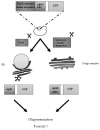Recent Insights on Alzheimer's Disease Originating from Yeast Models
- PMID: 29970827
- PMCID: PMC6073265
- DOI: 10.3390/ijms19071947
Recent Insights on Alzheimer's Disease Originating from Yeast Models
Abstract
In this review article, yeast model-based research advances regarding the role of Amyloid-β (Aβ), Tau and frameshift Ubiquitin UBB+1 in Alzheimer’s disease (AD) are discussed. Despite having limitations with regard to intercellular and cognitive AD aspects, these models have clearly shown their added value as complementary models for the study of the molecular aspects of these proteins, including their interplay with AD-related cellular processes such as mitochondrial dysfunction and altered proteostasis. Moreover, these yeast models have also shown their importance in translational research, e.g., in compound screenings and for AD diagnostics development. In addition to well-established Saccharomyces cerevisiae models, new upcoming Schizosaccharomyces pombe, Candida glabrata and Kluyveromyces lactis yeast models for Aβ and Tau are briefly described. Finally, traditional and more innovative research methodologies, e.g., for studying protein oligomerization/aggregation, are highlighted.
Keywords: Alzheimer’s disease; Tau; aggregation; amyloid β; oligomerization; prion; ubiquitin; yeast.
Conflict of interest statement
The authors declare no conflicts of interest.
Figures



Similar articles
-
Application of yeast to study the tau and amyloid-β abnormalities of Alzheimer's disease.J Alzheimers Dis. 2013;35(2):217-25. doi: 10.3233/JAD-122035. J Alzheimers Dis. 2013. PMID: 23396350 Review.
-
Alzheimer's Disease: Significant Benefit from the Yeast-Based Models.Int J Mol Sci. 2023 Jun 6;24(12):9791. doi: 10.3390/ijms24129791. Int J Mol Sci. 2023. PMID: 37372938 Free PMC article. Review.
-
UBB+1 reduces amyloid-β cytotoxicity by activation of autophagy in yeast.Aging (Albany NY). 2021 Nov 9;13(21):23953-23980. doi: 10.18632/aging.203681. Epub 2021 Nov 9. Aging (Albany NY). 2021. PMID: 34751669 Free PMC article.
-
Yeast Model of Amyloid-β and Tau Aggregation in Alzheimer's Disease.J Alzheimers Dis. 2015;47(1):9-16. doi: 10.3233/JAD-150173. J Alzheimers Dis. 2015. PMID: 26402750 Review.
-
Application of yeast to studying amyloid and prion diseases.Adv Genet. 2020;105:293-380. doi: 10.1016/bs.adgen.2020.01.002. Epub 2020 May 4. Adv Genet. 2020. PMID: 32560789 Free PMC article. Review.
Cited by
-
Saccharomyces cerevisiae as a Model for Studying Human Neurodegenerative Disorders: Viral Capsid Protein Expression.Int J Mol Sci. 2023 Dec 7;24(24):17213. doi: 10.3390/ijms242417213. Int J Mol Sci. 2023. PMID: 38139041 Free PMC article. Review.
-
Reduced Cerebral Glucose Uptake in an Alzheimer's Rat Model With Glucose-Weighted Chemical Exchange Saturation Transfer Imaging.Front Aging Neurosci. 2021 Mar 17;13:618690. doi: 10.3389/fnagi.2021.618690. eCollection 2021. Front Aging Neurosci. 2021. PMID: 33815088 Free PMC article.
-
Screening and Identification of Potential Peripheral Blood Biomarkers for Alzheimer's Disease Based on Bioinformatics Analysis.Med Sci Monit. 2020 Aug 19;26:e924263. doi: 10.12659/MSM.924263. Med Sci Monit. 2020. PMID: 32812532 Free PMC article.
-
Mitochondrial Neurodegenerative Diseases: Three Mitochondrial Ribosomal Proteins as Intermediate Stage in the Pathway That Associates Damaged Genes with Alzheimer's and Parkinson's.Biology (Basel). 2023 Jul 8;12(7):972. doi: 10.3390/biology12070972. Biology (Basel). 2023. PMID: 37508402 Free PMC article. Review.
-
The Promising Role of Selenium and Yeast in the Fight Against Protein Amyloidosis.Biol Trace Elem Res. 2025 Mar;203(3):1251-1268. doi: 10.1007/s12011-024-04245-x. Epub 2024 Jun 3. Biol Trace Elem Res. 2025. PMID: 38829477 Free PMC article. Review.
References
-
- Prince M., Guerchet M., Prina M. The Epidemiology and Impact of Dementia: Current State and Future Trends. [(accessed on 26 March 2015)]; Available online: http://www.who.int/mental_health/neurology/en/
Publication types
MeSH terms
Substances
LinkOut - more resources
Full Text Sources
Other Literature Sources
Medical
Molecular Biology Databases

